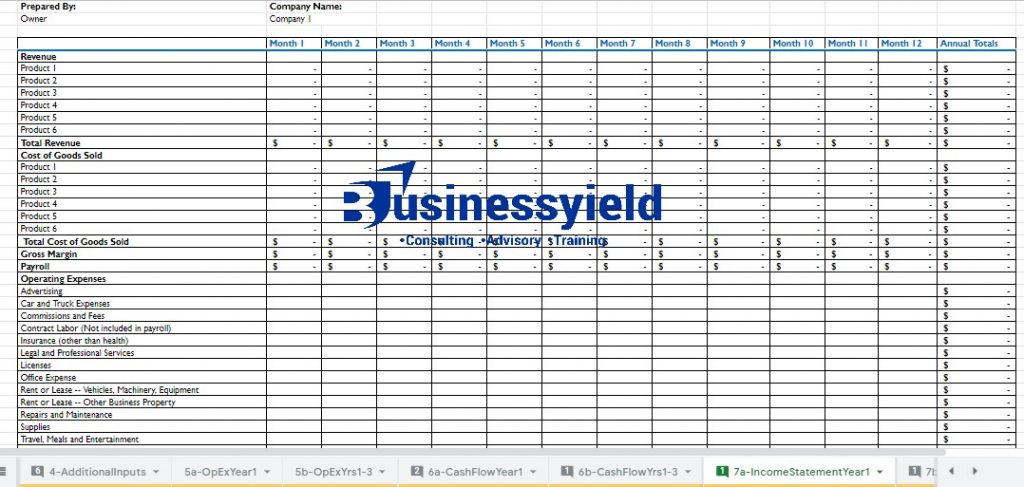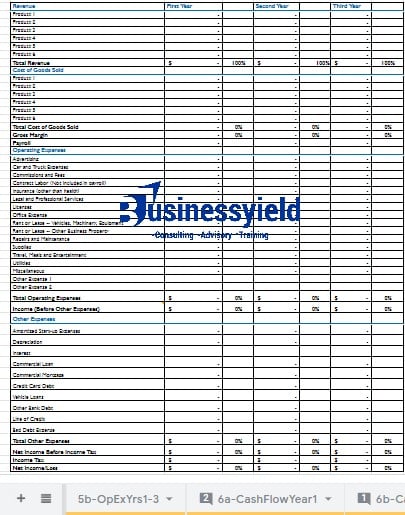Accounting is a topic that few small business owners are interested in. However, as everyone gets to find out, understanding the fundamentals of accounting, to a large extent, determines your company’s success or failure. In other words, you should be familiar with three financial documents: balance sheets, cash flow statements, and profit and loss statements (P&L). On the surface, they all appear to be a bit bothersome and complicated, but when you break them down one by one, they’re actually quite simple, especially when you have a free profit and loss statement template at your disposal. This P&L statement template fits perfectly into any company’s business plan, ranging from small businesses to large corporations
This article is all about profit and loss (P&L) )statements templates. But, to bring you up the speed, I will go over a few basics.
See Template Below:
What is a Profit and Loss Statement (P&L)?
A profit and loss statement is also known as an income statement. It tracks your company’s revenue (or sales) and expenses over time.
In other words, a profit and loss statement shows whether or not your company is profitable. It is basically used by small business owners to evaluate their performance and find areas for improvement and new growth ideas.
According to the US Small Business Administration, it’s the “best instrument for determining whether your business is profitable.”
A P&L statement is often evaluated throughout the following time periods:
- Monthly
- Quarterly
- Annually
And because they are only a few lines long, certain P&L statements and templates are relatively straightforward to create and interpret.
Others have the ability to span into multiple pages. Although that depends on the size, stage, and complexity of your company.
A small business with a few sources of income or expenses will have a short P&L, whereas a huge company with various sources of income will have a longer one.
Finally, how does a “statement” appear? A P&L statement is essentially a table that can be made in any spreadsheet program (Excel, Google Sheets, etc.).
What Is The Purpose of a Profit and Loss Statement?
In general, a P&L statement is used to determine your net operating profit or loss.
If you make a profit, that’s fantastic! You can reinvest it, save it, or do something else with it. If you lose money, it’s an indication that your company is on an unsustainable path, and you’ll need to figure out how to turn things around.
A P&L, in this regard, will be used to assist you in making educated decisions, starting with questions such as:
- Are you able to afford to hire new employees?
- Are you able to relocate to a larger office?
- What strategy will you use to plan your taxes?
- Is your present expansion strategy working?
Depending on who is looking at the P&L statement, it can also be used for other purposes.
Lenders and Investors
Investors, for example, will examine your P&L records from several time periods to determine how successful your company has become over time. They can also gather data about your operations’ efficiency, competitiveness, and the viability of your company model.
Lenders will examine your P&L figures to see if your company is likely to produce a profit large enough to repay loans and interest in the future.
However, there are certain limits to what P&L statements can do. They do not indicate your company’s financial health on their own. They may reflect it in some circumstances, but billing practices or fraudulent transaction reporting can skew (or mislead) them (whether intentionally or not).
To find out more about this, you can go through our post on income statements.
Free Profit and Loss Statement Template (P&L Template)
To easily build your own income statement, use BusinessYield’s free Profit and Loss statement template (P&L template).
This is a full financial projections template. In other words, you’ll also find a template for other aspects of a financial statement. Below is a guide on how to use them.
How to use the Free Profit and Loss (P&L) Statements Templates
First, it is important to understand that, at least 99% of what you do on your financials is based on real-time forecasts (for startup businesses) and real-time data for already existing businesses.
So to make the most of your templates, take these steps:
- Click on the Google Sheet here (see all free templates)
- Download the Google Sheet by clicking on “File” by the top left or better still click on the download button at the beginning of the post.
- Fill in the blanks, replacing all the orange cells with your company’s information. But note that to create your income statement, you’ll have to start filling the blanks from the first sheet.
- Concentrate on the captions and orange cells. Inserting values on theses cells turn them into light yellow. On the other hand, the white cells are set with formulas to auto-fill themselves based on data from the former.
- Double-check that all of the formulas in the white cells are correct.
- Download as a new file and consider saving in a PDF and XLS version.
Monthly Profit and Loss Statement Template (P&L Template)
The monthly P&L template is ideal for firms that need detailed reporting on a regular basis. When all of the data is displayed in a series of monthly columns, far more detail can be seen than if only the annual values are displayed.
The monthly profit and loss template is ideal for small, medium, and big businesses since it can be readily customized to include or exclude details as needed. Learn more about cash flow forecasting on a monthly basis.
However, on this template, your income statement is based on values on the sales forecasting sheet. In other words, if you fill in the blanks on the sales forecasting sheet correctly, your monthly profit and loss statement is generated automatically.

Annual Profit and Loss Statement Template (P&L Template)
An annual (full fiscal year or year-to-date) statement may be useful for businesses that have been in existence for several years. The annual profit and loss statement template below has the same format and structure as the monthly version, but it lacks a total column at the end that sums up each period.
This template is suitable for any size company and can be easily customized by adding or removing line items (rows) as required. It can also be used to perform year-over-year (YoY) comparisons.
Meanwhile whether as a startup, small business, or large corporation, you can employ the services of professionals if you find this cumbersome.
The Template’s Components
While every company’s income statement is different, there are a few common line items that you’ll see time and time again.
The following are the most typical P&L line items:
- Revenue streams
- Cost of Goods Sold
- Total Net Revenue
- Returns, Refunds, Discounts
- Advertising & Promotion
- Gross Profit
- Salaries, Benefits & Wages
- Depreciation & Amortization
- Rent and Office
- Travel
- Telecommunication
- Selling, General & Administrative (SG&A)
- Utilities
- Interest Expense
- Earnings Before Interest & Taxes (EBIT)
- Income Taxes
- Earnings Before Taxes (EBT)
- Net Earnings
How to Alter the Profit and Loss Spreadsheet (P&L Statement Template)
All of the templates on the Google Sheet may be simply altered and customized to fit your specific needs.
If you need more line items, simply add extra rows to the section where you’ll be entering revenue or spending information. Then double-check that the calculations that sum up the totals and include the new rows.
If you need to eliminate line items from the templates, simply delete the superfluous rows and double-check that all formulas are still valid.
Can I Do My Own Profit and Loss Statement?
Yes, definitely, you can do your own profit and statement, especially with the template on this post. However, they’re also tons of software out there to help you with this without having to raise a finger.
What Is Included in Statement of Profit and Loss?
The following are some P&L line items:
- Revenue streams
- Cost of Goods Sold
- Total Net Revenue
- Gross Profit
- Net Earnings
What Is a P&L Statement Template?
A P&L Statement Template is a pattern, model, or guide for the creation of a monthly and annual income statement.
How Do I Create a P&L Statement in Excel?
How to Make an Excel Profit and Loss Statement
- Open and save the Excel template after downloading it.
- Enter your company name and statement dates.
- Calculate the Gross Profit.
- To calculate gross revenue, input sales revenue.
- Fill in the cost of goods sold (COGS)
- Calculate your net income.
- Fill up the blanks with your business expenses.
What Are the 3 Steps to Calculating Profit & Loss?
To determine the accounting profit or loss you will:
- sum up all your income for the month.
- Add up all of your monthly expenses.
- Subtract entire expenses from total revenue to compute the difference.
- The result is your profit or loss.
- Balance Sheet vs. Income Statement: Examples, Diiffernces & Relationship
- Free Example of a Business Plan
- FINANCIAL STATEMENT OF A COMPANY: Best 2023 Samples & Templates to Learn From
- FINANCIAL REPORTING: All you need to know with Examples (+ quick easy tools)
- Balance Sheet vs. Profit and Loss Statement: Relationships & Differences







